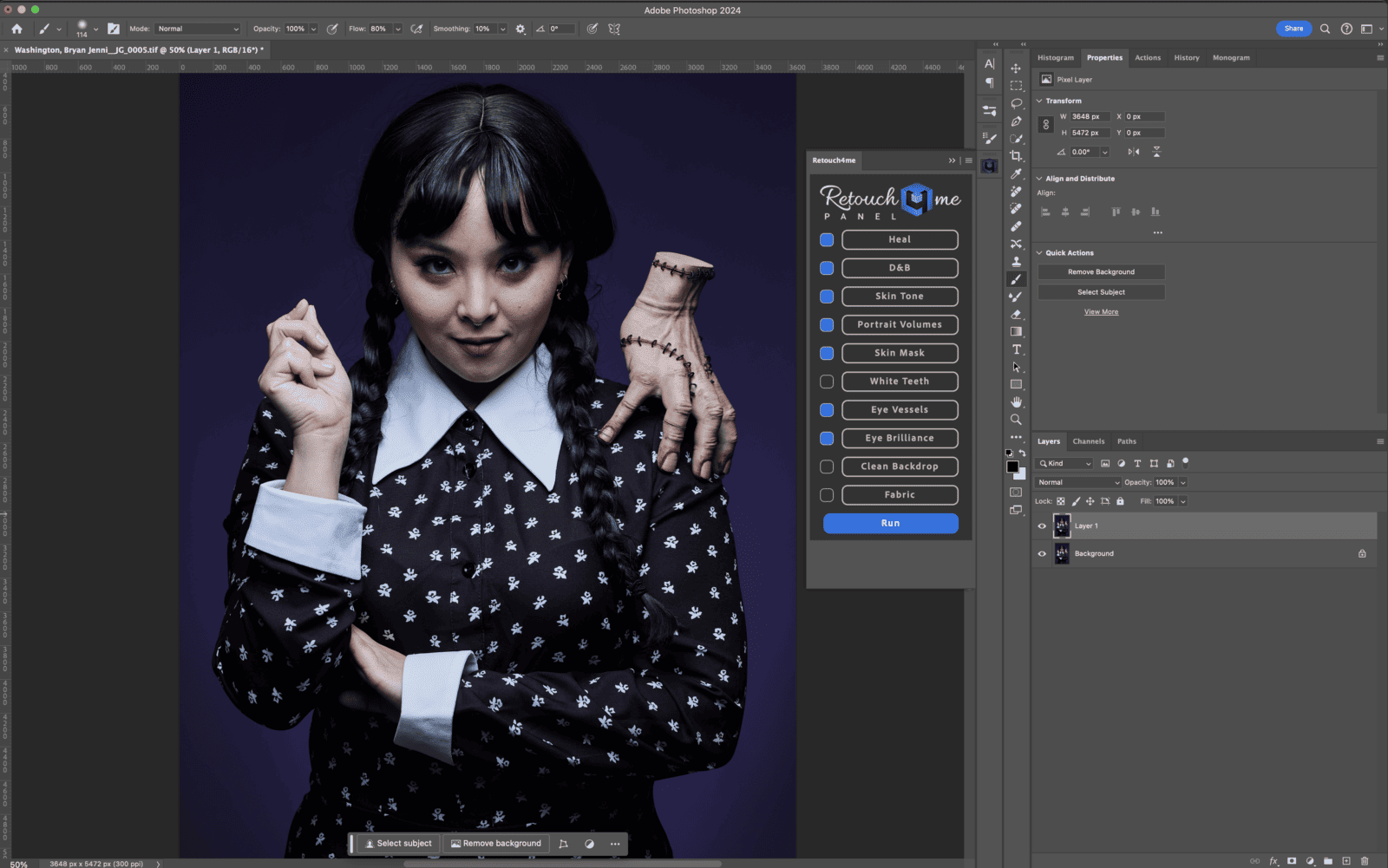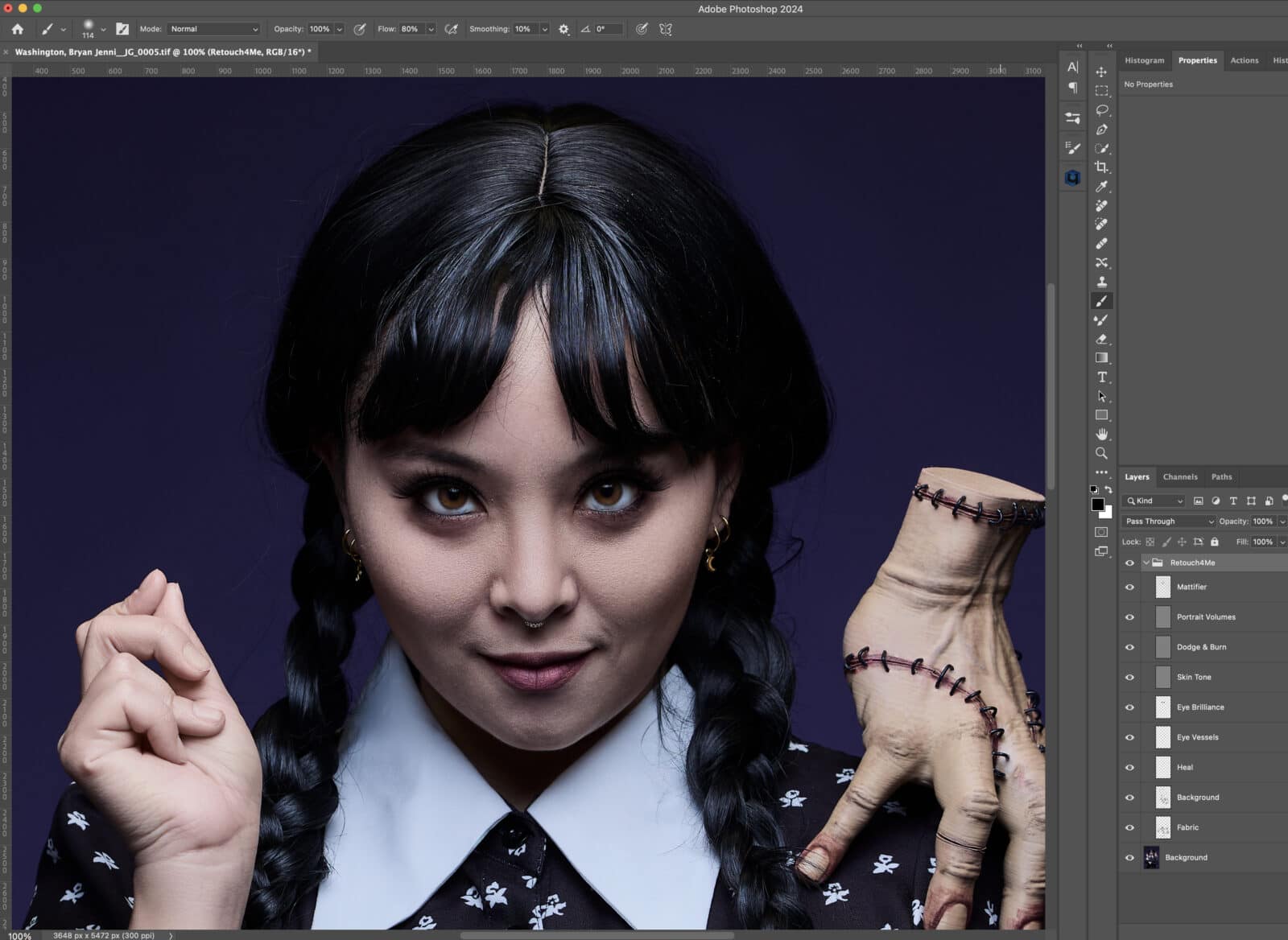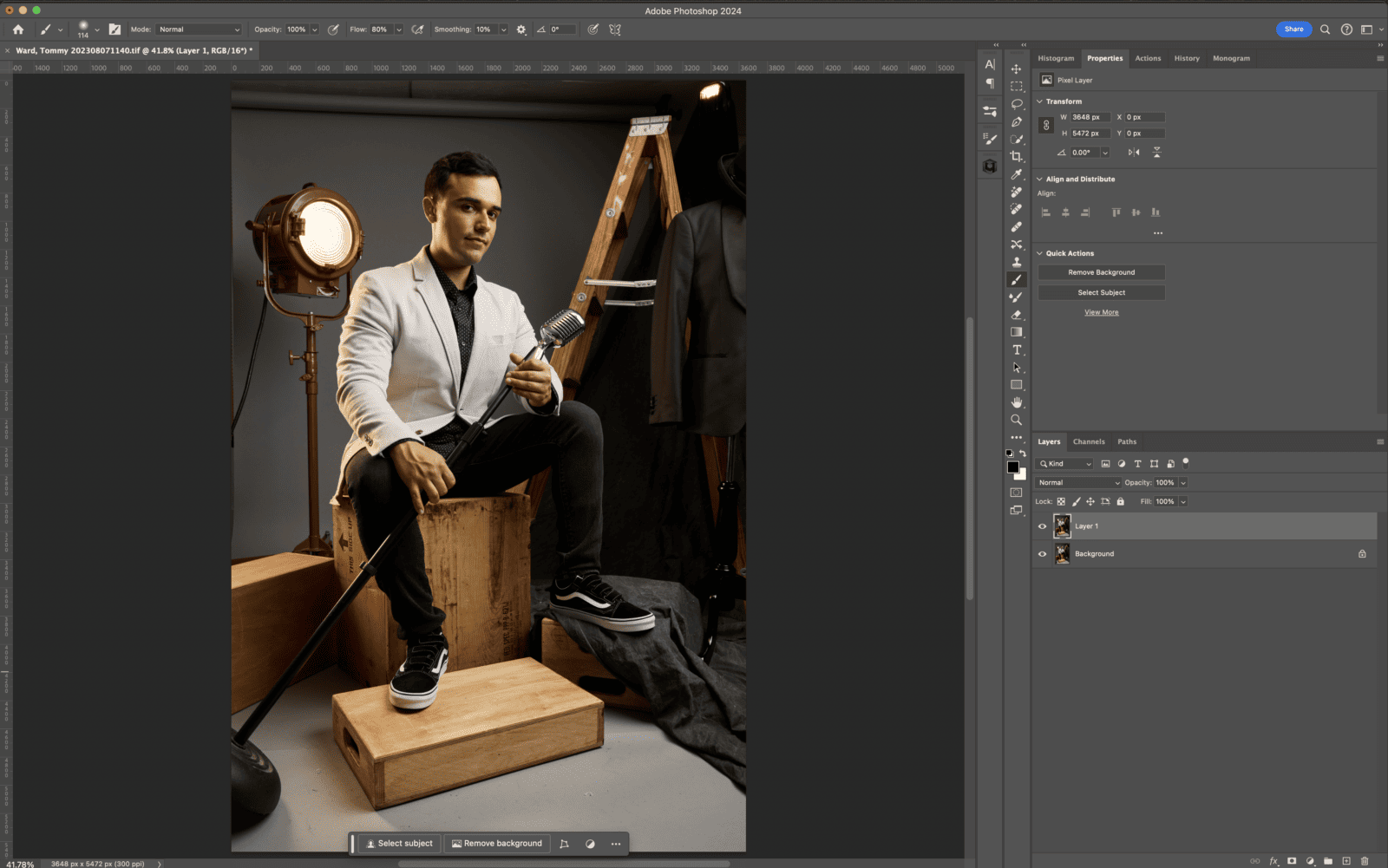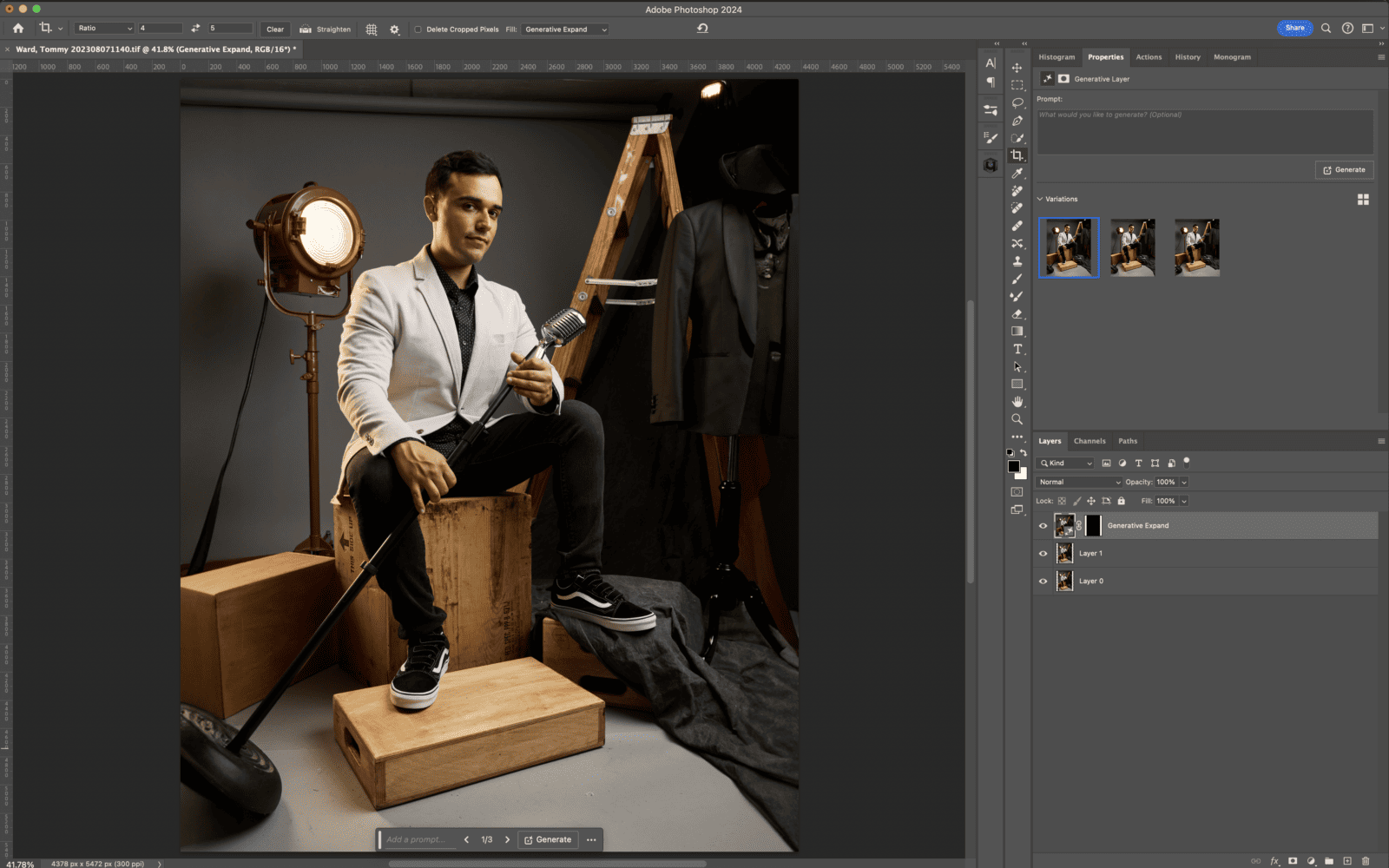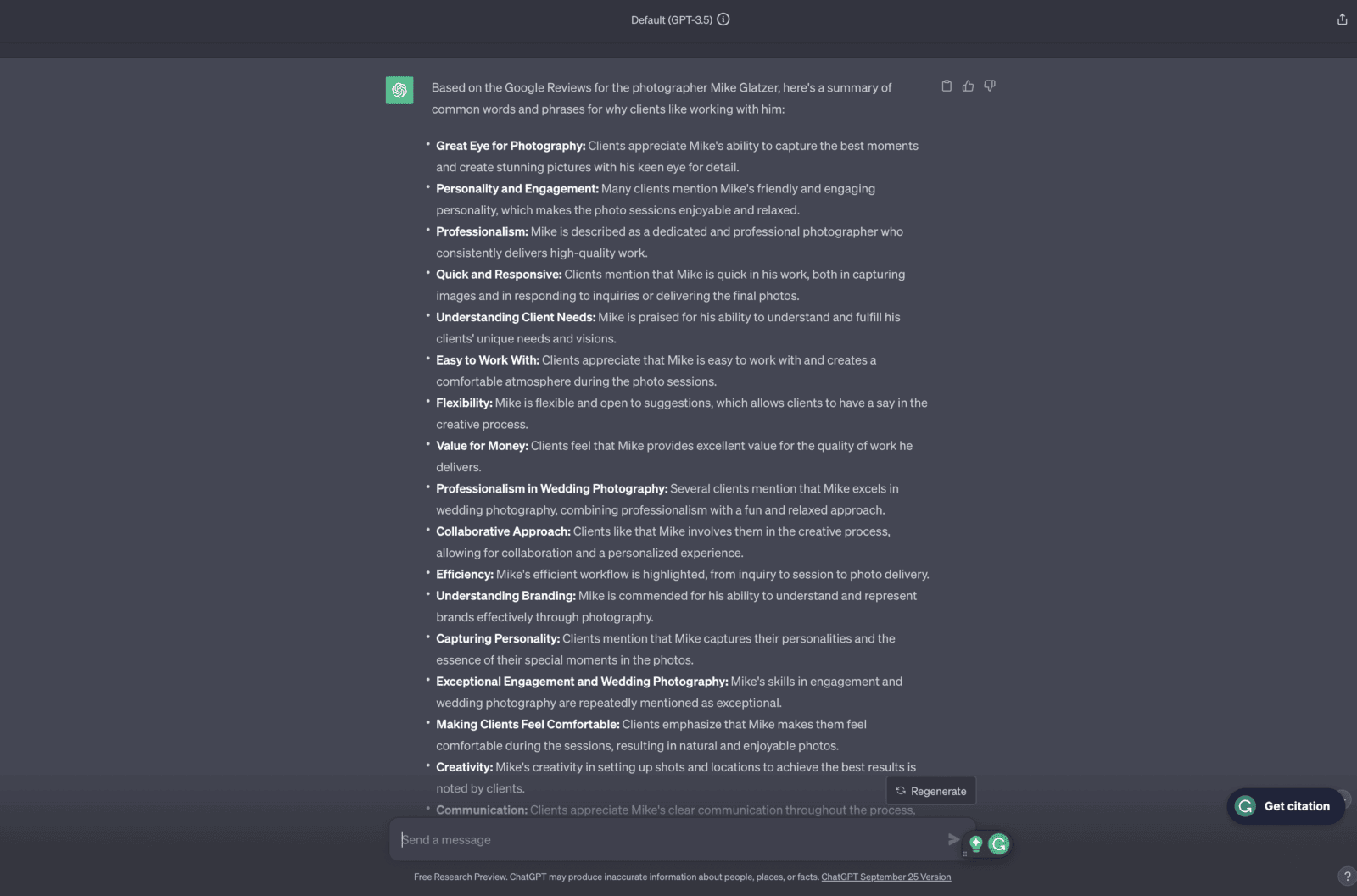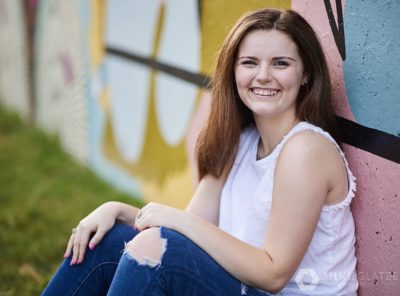Revolutionizing Portrait Photography: How I Use AI
I’m a tech nerd and often consider myself an early adopter of new technologies. It’s why I usually have the latest Apple OS downloaded on my iPhone and MacBook, even if it makes some of my programs buggy until they catch up. Because of that, I’m constantly researching and testing new tools to make my life easier, to remove the mundane, and to let me focus on what I love – creating and working with people. There are new tools that implement Artificial Intelligence (AI), which are powerful and can be leveraged in amazing ways. In this blog post, I want to walk through how I use AI in my portrait photography business, both to be educational and transparent.
AI Portrait Retouching
The new AI tools for retouching and working with images are insane. I love creating my pictures, but I never enjoyed retouching them. I’d rather be working with my lights and camera, talking to the human before me, than sitting on my computer trying to remove stray hairs from a patterned shirt. It just doesn’t excite me. So, I’m always looking for tools that can let me spend more time working with my clients.
AI Culling with Aftershoot
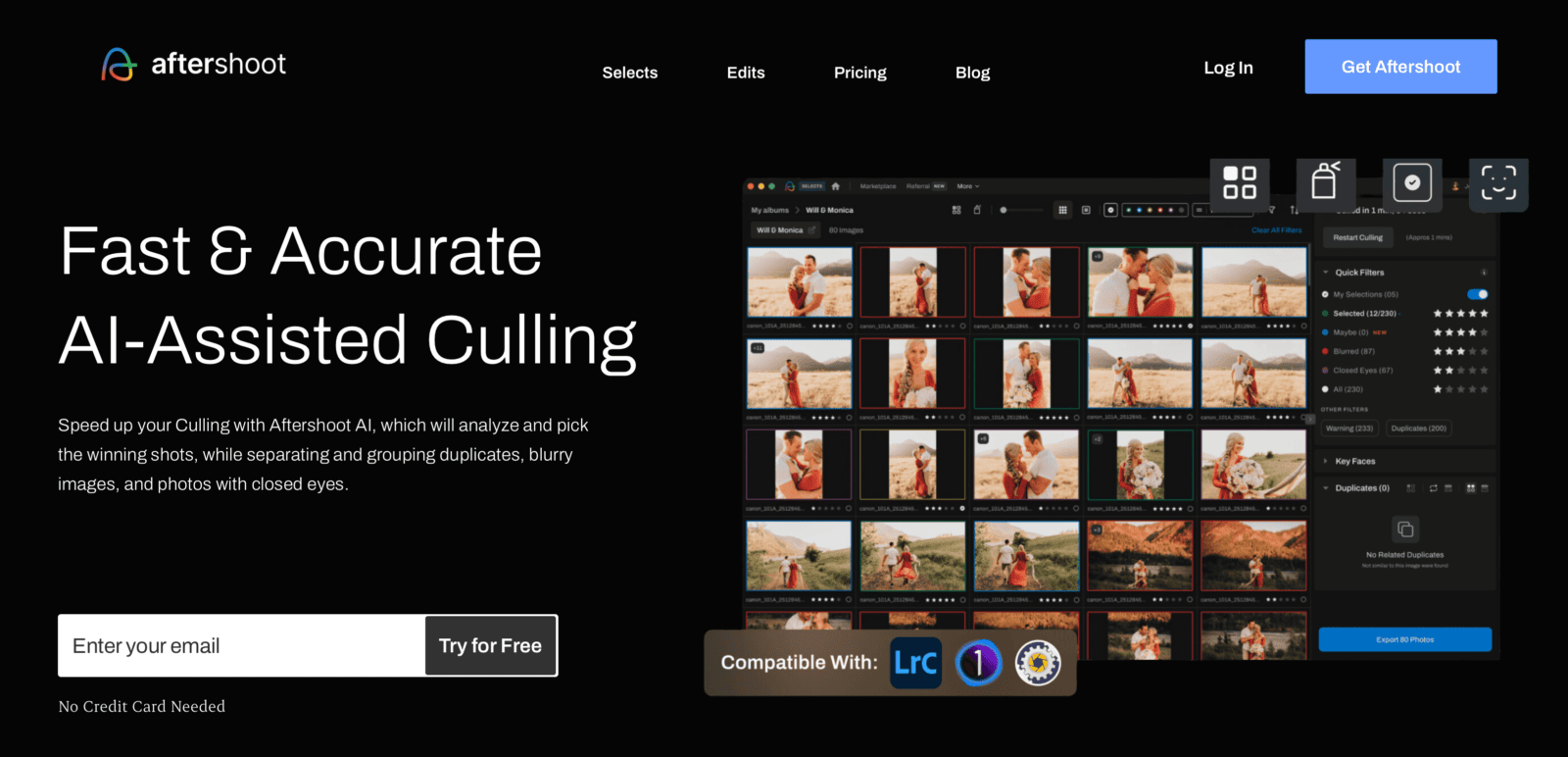
The first step after a photoshoot is to go through the images and remove the duplicates, blinks, process & test shots (if I tweak my lighting, I’ll snap a few frames to make sure it looks good before posing my client), or just bad images (and yes, every photographer takes them). In the past few years, I’ve gotten more intentional when I press the shutter button, which means fewer images taken during a portrait session and fewer images to go through on my computer. Unfortunately, it’s still a lot. While I may show a client 60 proof photos, I’ve already removed 300. This process of sorting through images is called Culling. I hate it. Culling a session takes 45 minutes to an hour, depending on the session.
Now, I only need 15 minutes. Several companies recently introduced AI software that automatically sorts, culls, and ranks your images for you. My personal favorite is Aftershoot for the simple reason that it works with Capture One, my raw image processing software. Every other AI culling software only works with Adobe Lightroom.
Aftershoot will import my image catalog and then sort it based on the kind of session (wedding, portrait & headshot, event, and more!). Once sorted, I’ll go through its selections and tweak where I may disagree (and it’s usually a very subtle difference of opinion). For a typical portrait session, Aftershoot takes about 5 minutes to do the culling process and then 10 minutes for me to walk through and check it. Honestly, I could probably skip my check process and still be happy with the results 95% of the time.
Aftershoot has also recently added global retouching to its AI platform. You can purchase existing editing presets or upload your previous images and have the program learn your editing style. Once it’s learned your style (they recommend giving it 5,000 images or more), it’ll cull and edit all in one go. It’s really incredible. I don’t use the AI edits feature yet because my editing style changes based on the shoot. Maybe I’ll try it one day, but doing global edits has never been a significant time suck for me.
Retouch4Me for AI Portrait Editing
It’s time for detailed editing once culling and global edits are knocked out. Detailed editing is super time-consuming. Removing skin blemishes, fixing color casts in the skin, removing flyaway hairs, cleaning up & shaping hair in general, removing wrinkles and loose threads in clothing, cleaning up backgrounds of dirt and debris, and then adding contouring via a process called Dodging and Burning is tedious and can take a full hour for a single portrait. It makes a massive difference in how the final image looks, but it’s mind-numbing work, and honestly, sometimes I just don’t have the patience to do it all.
Meet Retouch4Me. A series of standalone Photoshop Plugins, these modules do all kinds of retouching that is simply mindblowing.
- Dodge & Burn
- Portrait Volumes
- Portrait Healing (skin retouching)
- Eye Vessel Removal
- Eye Brilliance (makes eyes POP)
- Backdrop Cleanup (only good for studio backdrops)
- Skin Tone
- Whiten Teeth
- Fabric (removes wrinkles)
- Skin Masking (creates selective masks for face, non-face, and all skin)
- Mattifier (removes highlights)
And I can do them all in just one click. Two minutes later, my image is fully retouched with all of these steps performed or my selection of just a few. I can adjust how much each one applies the effect, too. At first, I thought, “There’s no way it can be that good.” After comparing the results to work, I would have done or some retouchers’ I’ve hired – yes, it is. Getting as good, or better, results for my clients than if I did the work myself and in a fraction of the time?
If I don’t outsource my edits (usually for images with more unique retouching needs), I’m always using these actions to shorten my retouching time from an hour per image to approximately 15 minutes.

Retouch4Me Tools 
Unedited 
Edited with Retouch4Me
Photoshop AI – Generative Fill & Generative Expand
If you follow my work, you’ll know I love having random objects flying through the air. Something about that chaos is just fun for me, and possibly a subconscious outlet for the madness behind my super-organized brain. Anyways…
One of the challenges I often run into as a creative portrait photographer is that some props and locations are damn-near impossible to acquire or require a herculean effort to integrate. If I couldn’t get that prop in real life, I’d have to do a very time-consuming and tedious composite. If not done right, it looks awful and fake.
Just released as of this article is Photoshop’s Generative Fill feature. My composting days just got easier, and my ability to step up the creativity in my images has exploded—Generative Fill leverages Adobe Firefly, a massive stock image database. When used, Photoshop will search the database and match color, lighting direction, texture, you name it, and put that content into your selection.
For example, I extended the background floor on this image, which made it look empty and bland. I made a selection in Photoshop, chose the Generative Fill tool, and then typed in what I wanted (in this case, green muslin fabric and again for a wooden pallet). BAM – I have objects in the image that match the rest of the scene and look totally normal.

Original Image 
Foreground Elements with Generative Fill
Another example is this self-portrait. I wanted books falling in the background, but I didn’t want to risk damaging any books and lacked the extra hands to do the dropping action. So I used Generative Fill and told it “falling book” as a prompt. Without risking damage to any books or my back, I created the image in my mind.

Original Image 
Falling Books Added With Generative Fill
Some creators take advantage of this feature to do some insane compositing swaps. You can entirely change someone’s outfit with scary accuracy and fit. I think that’s taking it too far, but I love the potential. This means I can take unique, gorgeous, complicated portraits for my clients without spending a fortune on props or locations while simultaneously minimizing danger.
Additionally, there is Generative Expand. One of my favorite print products is Canvas. I love the texture of the material and the wrap-around effect so that the image can be appreciated in 3D. The downside of Canvas prints is that you can sometimes lose critical aspects of an image because some of it has to be wrapped around the frame. With Generative Expand, I can make an image “bigger” and Photoshop will fill in the empty space with contextually accurate data. For instance, if I want to post a picture with Instagram’s 4:5 ratio, I’ll need to crop off the legs or head of my subject because camera sensors have a 2:3 ratio (longer and narrower than 4:5). With Generative Expand, I can change the crop to 4:5, and Photoshop will add background to make it look like the original image. It’s pretty incredible and does it instantly.

Original Image at 2:3 Ratio 
Expanded Crop to Match 4:5 Ratio 
Generative Expand Applied
AI For Blogging
Okay, this might be a little meta to read about AI for blogging while reading a blog post, BUT – this post had zero AI used for the writing (just help in two adjacent spots that I’ll reveal in a moment).
I genuinely enjoy writing. I’m weird that way. Even doing technical documents for my engineering job was something I didn’t mind. Still, it’s time-consuming, and there are certainly days when I’ve sat at my desk and stared at my monitor, unsure how to write or frame a specific item. AI has been beneficial in reducing those burdens.
I use ChatGPT for my blogging, which has a lot of mixed feelings around it. I use it primarily as a research and structure tool, though sometimes I ask it for help with writing content itself.
AI for Blog Research
One of my favorite uses for ChatGPT is to throw a body of text at it, a hyperlink, an article, a URL, or a book, and ask it to summarize the content in a series of bullet points. If I’m in a time crunch and want to know the critical details of some text without reading it, ChatGPT does an outstanding job condensing it to the core points.
When brainstorming for a new blog post, I’ll often ask ChatGPT for details about a topic. It’s like having a research intern who will pull together information for me so I can determine if it’s something I can leverage for my next post. From there, I’ll try to add my twist and perspective and some added thoughts from my experiences. This could also include asking ChatGPT how most people search a topic in Google: “What common search terms are used for someone looking for an Atlanta corporate headshot photographer?”
Once I’ve selected a topic to blog about, I’ll often ask ChatGPT to help me write a catchy Title and Meta Description for that post, leveraging a specific keyword. This prompt optimizes the SEO of that post, which improves how it ranks on various search engines. For this post, I did exactly that!
AI for Blog Outlines
Once I know the topic I want to blog about and the keywords, I’ll write a list of the main points I want to list as headers. From there, I can ask ChatGPT to develop an outline using those keywords and headings. ChatGPT will create SEO-friendly headers that cover the discussion points and do so in a way that feels conversational vs. keyword stuffing (don’t do this).
Depending on the blog post, this may end my ChatGPT usage. I’ll then write out the content (body text) and add pictures with alt-text before posting.


AI for Blog Writing
I’ve done it. I’ve used ChatGPT to write blog posts for me. It’s crazy helpful because sometimes proofreading a first draft and modifying it is much easier than writing a post from scratch. And that’s a key point – I use ChatGPT as my crappy first draft. It gets the basics down before I add my personality and perspective. It shortens the overall writing process while providing good content and simultaneously doing a lot of research that’s included in the draft and probably in the final submission.
If I’m going to leverage ChatGPT for my first draft, I’m going to do it smartly. The goal is to reduce the time spent, not increase my workload! I achieved this goal by asking ChatGPT to create a draft based on specific criteria:
- Topic & keywords
- Number of words
- Inclusion of headings
- Based on my writing style (I ask it to sample previous blog posts)
- Perspective, audience, and tone
I had to do a lot of research to develop a prompt with all of these criteria.
Worth it.
I can get a 2,500-word blog post with SEO-friendly keywords and headers in a matter of minutes. From there, I’ll go through ChatGPT’s draft and edit it. This process usually takes about 30 minutes to an hour. That may seem like a lot, but it cuts down the overall writing process by about 3 to 5 hours because I like writing fewer but overall longer blog posts.
AI and Website Development
I use ChatGPT very similarly for my website as I do for blogging. Having said that, I work with a copywriter 99% of the time (Krista Walsh Copywriter, is fantastic and highly recommended, by the way). ChatGPT comes in handy when doing competitor research to determine how I want to leverage my marketing and keywords.
One of my favorite tricks is to copy all the Google Reviews from a photographer and paste them into ChatGPT. I’ll then ask it to generate a bullet list of common words or phrases describing that photography service from those reviews.
I also used this on client reviews for my portrait services to help craft language for my website. It’s brilliant.

Copying Google Reviews 
Prompt with Reviews in ChatGPT 
ChatGPT Review Summary
Lastly, if I do write new content for my website, I’ll often throw those paragraphs into ChatGPT and ask it to shorten my text. I’m a bit wordy, and most people want something brief on a website.
AI for Writing Emails
Before my life as an engineering project manager, my communication skills were solid but could have been more exemplary. They’re much better now, but I feel I can always do better. So, I leverage ChatGPT to help me craft emails that are short, sweet, and to the point while still being empathetic and engaging. As I mentioned, I’m wordy, and I’ve often found more text gets read less. So once I create my first draft of an email, I’ll plug it into ChatGPT and ask it to revise with a specific goal in mind. I get my message across, and the chance of my clients reading all that information increases substantially. It’s a win for everyone.

What I Don’t Like About AI
Yes, even though I leverage AI a lot in various aspects of my portrait photography business, there are still many aspects of AI that I don’t like. Frankly, it’s not so much AI itself but its usage that frustrates me. I’ve seen many people assume that they can let AI do everything for them, from blog writing to image creation and editing to organizing their lives. I’m not a fan of that kind of reliance or exploitation.
Yes, AI is great for doing menial work and lets people do what’s terrific about us-combining and creating unique and novel concepts. However, completely offloading all work to AI is irresponsible and lazy, in my opinion. That’s how you end up with lousy information getting spread, like lawyers using arguments based on imaginary legal precedents.
I also worry that it makes creators lazy. There’s something to be said about learning all the technical aspects of your craft so you know how to create something. With AI, creators can create amazing images, but there’s a concern about where the line gets drawn between digital art and photography (or similar for other artistic ventures).
I like using AI as a tool to help me create, not to do all the work for me.
Conclusion
I think we’re still in the early stages of what AI can do. It’s both disturbing and inspiring. With responsible usage, I believe AI will bring unprecedented improvements to the world. I look forward to learning and leveraging it to continue bringing the best experience to my clients. And take away some of the mundane from my everyday life so I can focus on spending more time with friends and family! What do you think? Is AI worthwhile? Are you using it yet?

